Physical Address
304 North Cardinal St.
Dorchester Center, MA 02124
Endorectal and endoanal ultrasound (ERUS and EAUS, respectively) examinations are used to diagnose benign and malignant abnormalities of the rectum and anus. ERUS has been used extensively for local staging of rectal cancer and continues to have a significant role in preoperative staging of rectal tumors. Ultrasound plays less of a role in the evaluation of tumors after chemoradiation. One of the main uses of EAUS has been in the evaluation of anal sphincter injuries in patients with fecal incontinence. It has also been used for the evaluation of complex anorectal abscess/fistulas. The procedures can be done in the office setting with portable equipment and no sedation. Minimal preparation is required, tolerance by patients is high, and the results are readily available. The cost of ERUS is significantly less than other radiologic tests, often with equivalent results. This chapter discusses the use of ERUS and EAUS for the evaluation of malignant and benign abnormalities of the rectum and anus.
ERUS can be performed in the office setting with minimal patient preparation. Patients are instructed to use one or two enemas prior to the office visit because fecal material within the rectum causes image artifacts. Examinations are performed in the kneeling prone or left lateral position, depending on practitioner preference. Initial proctoscopic examination is done prior to the ERUS for evaluation of rectal tumors. Any residual fecal material and enema effluent can be suctioned out to decrease image artifacts. The distance from the tumor to the anal verge is measured, the location of the tumor on the rectal wall and the size of the rectal lumen through the tumor are noted. Ideally the ultrasound probe needs to be passed proximal to the lesion for complete evaluation because adenopathy is typically found proximal to the rectal cancers. A narrow lumen and a fixed, stenotic lesion will not allow passage of the rigid ultrasound probe easily, causing patient discomfort and decreasing the accuracy of imaging.
There are several ultrasound probes that rotate 360 degrees to give a radial image of the rectum, perirectal tissues, and the anal canal. Older probes have fixed crystals at the end of the probe. A balloon is used to cover the crystal at the end of a fixed probe. These probes are rigid and are advanced through a proctoscope, allowing accurate placement above tumors. The length of the proctoscope and probe limit tumor evaluation to the rectum. The proctoscope is passed proximal to the tumor, and the lubricated probe (with balloon covering the transducer crystal) is passed through the proctoscope to a point above the lesion (ideally 15 to 20 cm from the verge to completely evaluate the mesorectum). After the probe is in place, the proctoscope is pulled back slightly and the balloon is filled with degassed fluid to distend the lumen of the bowel. Probes with stationary crystals require approximately 60 mL of liquid to distend the balloon at the end of the probe. It is important to ensure that there are no air bubbles in the balloon because the air causes acoustic impedance (with bright white scattering).Both probe and proctoscope are withdrawn through the rectum to obtain images. Blind insertion of the ultrasound probe is possible, but it may be difficult to advance the probe proximal to the lesion and may cause the patient significant discomfort.
Newer probes have a crystal that moves within a portion of the distal shaft of the probe. A long balloon is fitted over the probe, which is passed through a specialized proctoscope. The proctoscope is partially withdrawn, exposing the area on the probe where the crystal moves and locked into place. The balloon is filled with degassed liquid, distending it along the entire length of the probe. The balloon covering the probe is large and requires more than 200 mL to distend it and rectal wall adequately. The operator moves the crystal up and down the shaft by pressing controls on the probe. Images can be obtained and stored in real time. The crystal travels approximately 7 cm, so it may be necessary to pull the proctoscope and probe lower and perform a second pass to completely evaluate the length of the rectum.
Flexible endoscopes with mounted ultrasound tips are available and allow evaluation of lesions proximal to 15 cm. These are typically used by gastroenterologists and will not be discussed in this chapter.
The fixed ultrasound probes have interchangeable crystals with several transducer capabilities. A 7-MHz transducer provides a focal length of 2 to 5 cm and is used to evaluate deeper structures (perirectal lymph nodes). A 10-MHz transducer has a focal length of 1 to 4 cm and is the probe that is more commonly used (to evaluate the rectal wall and anal sphincter). The movable probes have multifrequency transducers, which allow the investigator to change frequency to improve visualization without needing to replace the crystal at the end of the probe.
Older machines are two dimensional, which allows for video recording and photodocumentation of static images. Three-dimensional (3D) ERUS produces high-resolution, multiplanar images. These images can be rotated and viewed from different angles in an attempt to improve the diagnostic accuracy of the ERUS. Tumor volume can be measured and the relationship between the tumor and contiguous structures better understood.
Images are generated depending on the transducer model used. The stationary probe and proctoscope are withdrawn slowly through the rectum in an effort to identify perirectal lymph nodes and the tumor depth in the rectal wall. The image can be frozen to get still images of representative levels for chart documentation. Real time video documentation may also be obtained, saved, and reviewed. The movable crystal allows the probe to stay stationary above the tumor while the crystal advances through the tumor-generating images. The continuous 3D images can be stored, reviewed, and still images generated.
Ultrasound imaging is based on echogenicity of the tissues imaged. Tissues that have a higher fluid content appear black while interfaces and tissues with less fluid density appear white. Smooth muscle with a high fluid content appears black and skeletal muscle appears white. Beynon et al. described a five-layer model for interpreting imaging of the rectal wall in 1986, and it continues to be used today as seen in Fig. 147.1 . The transducer appears in the center of the image. The fluid-filled balloon is the central large black image surrounding the transducer. The first hyperechoic white line is the interface between the balloon and the mucosa. The inner hypoechoic black line represents the muscularis mucosae. The middle hyperechoic white line represents the submucosa. The next hypoechoic black line is the muscularis propria, and the outer hyperechoic white line is the interface between the muscularis propria and the perirectal fat. Fig. 147.2 shows the ultrasound appearance of a normal rectal wall. Blood vessels can be seen in the surrounding tissues and appear as hypoechoic circular structures, which can elongate as the probe is withdrawn. Lymph nodes tend to be more irregular shaped and can have mixed echogenicity. Seminal vesicles are seen anterior and appear as bilateral structures.
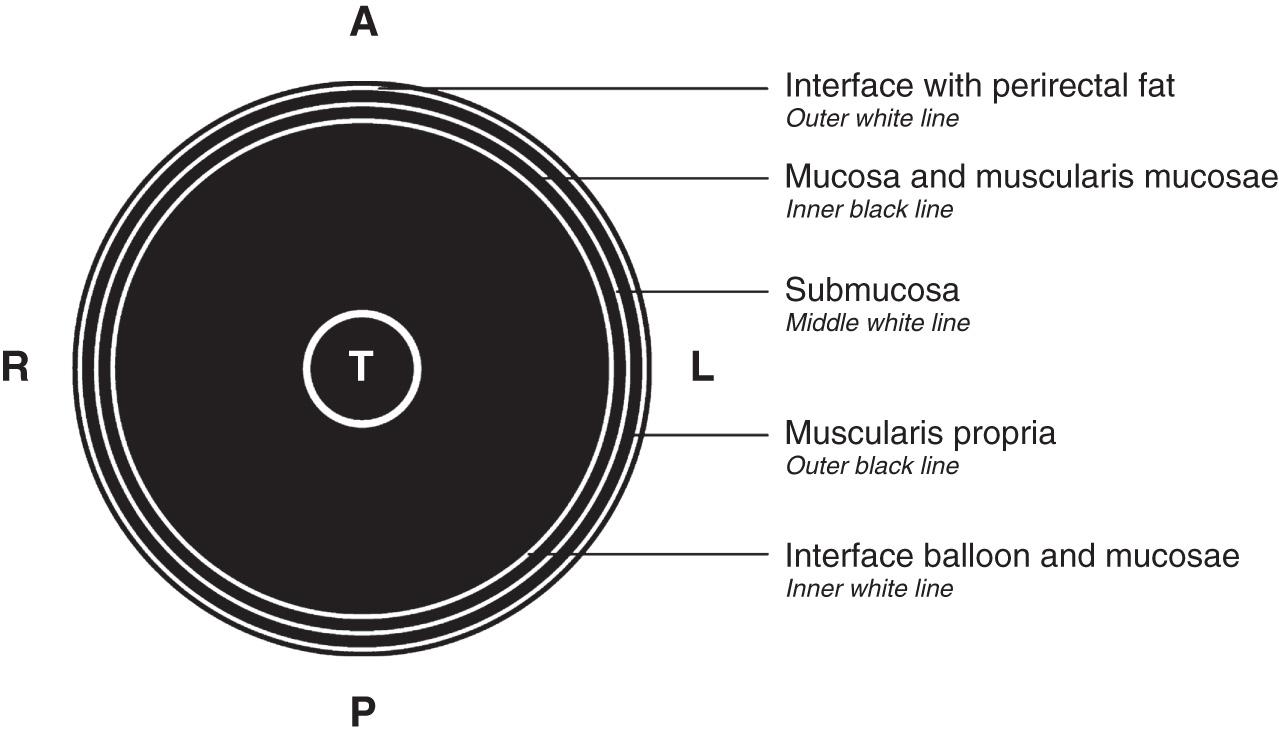
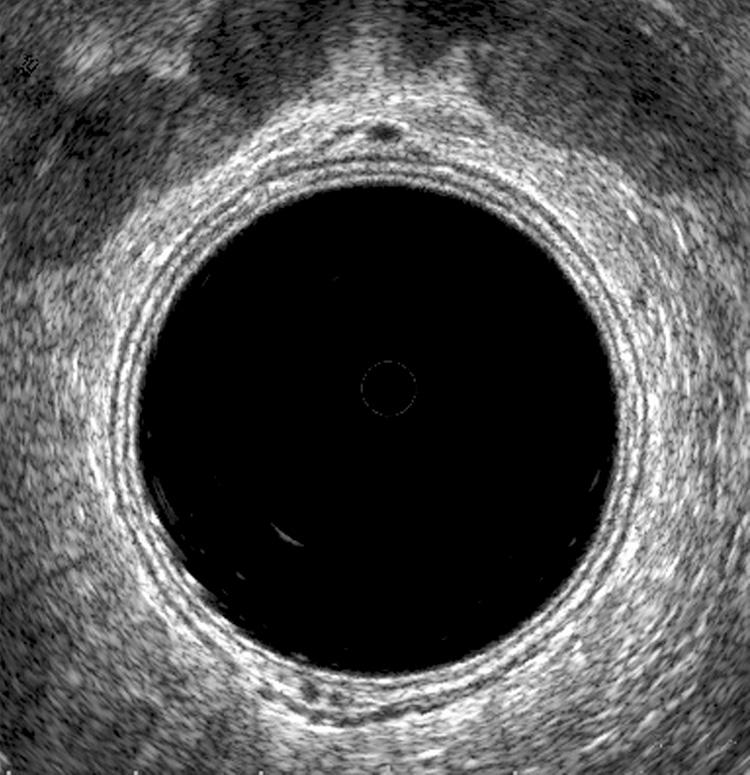
Digital rectal examination (DRE), ERUS, computed tomography (CT) scanning, and magnetic resonance imaging (MRI) are commonly used for staging of rectal cancers. Each of these modalities has its proponents and detractors. DRE is useful for evaluation of the fixation of low rectal cancers but cannot assess middle level and upper level tumors. ERUS is more accurate in assessment of the depth of wall invasion and lymph node involvement when compared with DRE. Zhou et al. performed a meta-analysis looking at studies of ERUS in the evaluation of rectal cancer. The pooled diagnostic sensitivity and specificity were 95% and 80%. Lymph node sensitivity and specificity were 58% and 80%.
CT scanning is useful for evaluating distant metastatic disease and involvement of contiguous organs but is less accurate for assessment of T stage of rectal cancers. MRI is becoming more popular in the assessment of circumferential resection margins (CRMs). MRI T stage accuracy and lymph node (LN) accuracy improve with the use of endorectal coil (T, 81%; LN, 63%) and is comparable with ERUS. Li et al. reported on a recent meta-analysis evaluating ERUS, CT, and MRI in patients not receiving preoperative chemoradiotherapy. They showed similar accuracy, but none of the tests provided reliable evaluation of lymph node metastases. Accuracy for early stage tumors (T0 to T1) and later stage tumors (T3 to T4) is high when staged by ERUS (97% and 88%, respectively). Identification of T2 lesions is poor (37%), with 21% overstaged, indicating that ERUS may not be useful for evaluating patients for a tailored surgical approach.
The phased array coil MRI has been shown to be highly accurate in the prediction of CRM in the MERCURY trial. These MRIs are an arrangement of multiple external coils and fast T2-weighted sequences, which are very accurate in prediction of CRM but have a low accuracy in predicting lymph node involvement. Several small studies compared ERUS and MRI for accuracy in determining CRM and found that the two modalities are similarly accurate. Accuracy of pretreatment staging may improve with multimodal imaging (MRI and ERUS).
ERUS can be done in the outpatient setting, it is portable and less expensive than CT and MRI. The accuracy of ERUS is operator dependent but has been reported to be as high as 95% for T staging and 80% for staging of lymph node metastases. Tumors appear as hypoechoic or mixed echogenic masses, which disrupt the layers of the rectal wall.
Ultrasound staging (prefix u ) of rectal cancers is a modification of the tumor, node, metastasis (TNM) staging system (pathology staging prefix p ) and was introduced in 1985 by Hildebrandt and Feifel. Table 147.1 lists the uTNM stage and correlating criteria for staging.
| Classification | Criteria |
|---|---|
| uT0 | Noninvasive lesion confined to the mucosa |
| uT1 | Tumor confined to the submucosa |
| uT2 | Tumor invades into but not through the muscularis propria, remains confined to the rectal wall |
| uT3 | Tumor penetrates through the entire thickness of the rectum and invades the perirectal fat |
| uT4 | Tumor invades an adjacent organ/structure |
| uN0 | No evidence of lymph node metastasis (no definable lymph nodes by ultrasound) |
| uN1 | Evidence of lymph node metastasis (ultrasonographically apparent lymph nodes) |
uT0 lesions are confined to the rectal mucosa and are noninvasive ( Fig. 147.3 ). The middle white line (submucosa) remains intact. Tubulovillous adenomas are benign uT0 lesions that can be seen expanding the mucosal layer (the first black line).
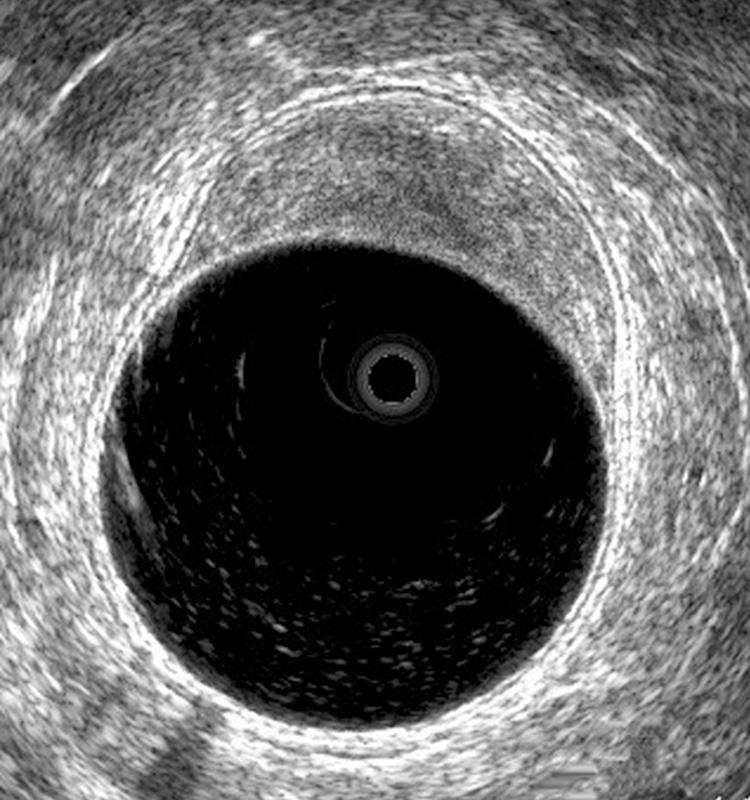
uT1 lesions invade the mucosa and submucosa but do not invade the muscularis propria (second black line). The middle white line (submucosa) is seen as thickened and irregular but not broken ( Fig. 147.4 ). If there is a break in the submucosa the muscularis propria is considered invaded and the lesion is staged as a uT2. Lymph node involvement can occur in 10% to 20% of T1 rectal cancers and ERUS may help to identify this subgroup of patients for whom local resection would be contraindicated. Staging accuracy varies from 47% to 96% for uT1 lesions.
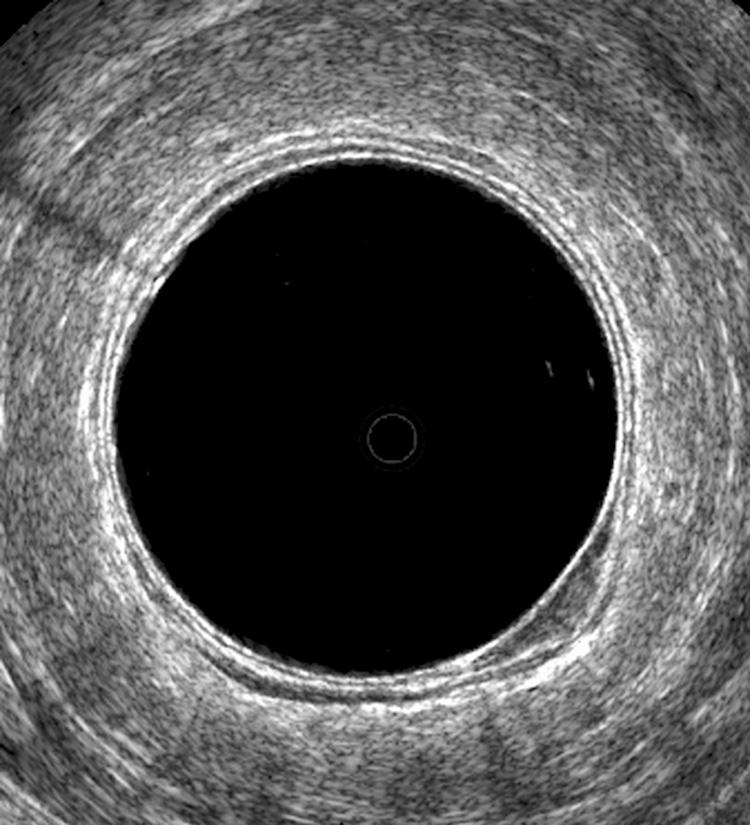
uT2 lesions cause disruption of the middle white line (submucosa) and expansion of the outer black line (muscularis propria). The outer black line (perirectal fat) is intact. There may be scalloping of the outer white layer, which may lead to overstaging of these lesions ( Fig. 147.5 ). The accuracy of uT2 staging is approximately 68%. Lymph node metastases can occur in up to 30% of T2 lesions and probably account for why there is a high local recurrence rate in T2 lesions treated by local therapy alone.
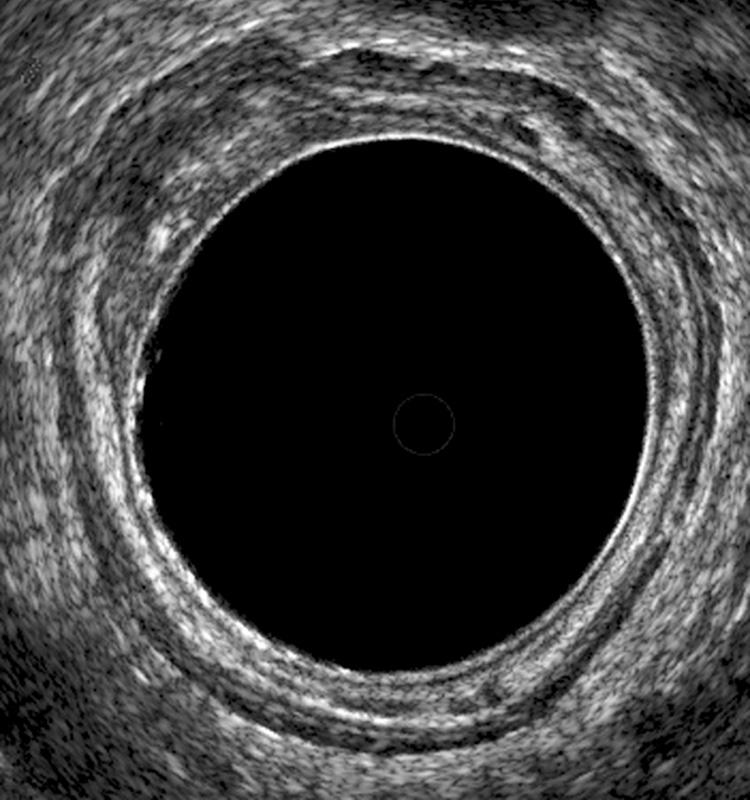
uT3 lesions involve the full thickness of the rectal wall and invade the perirectal fat, disrupting the outer white layer on ultrasound imaging ( Fig. 147.6 ). ERUS accuracy can be as high as 80% in diagnosing T3 rectal cancers. Lymph node metastases can occur in up to 66% of T3 rectal cancers.
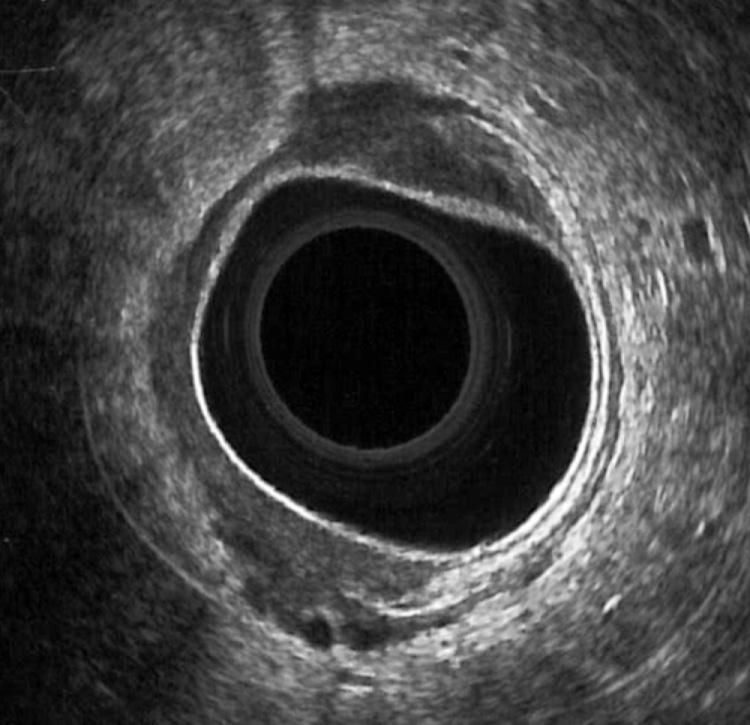
uT4 lesions invade contiguous structures such as the vagina, prostate, or seminal vesicles. The hyperechoic interface between these structures and the rectal wall is disrupted if there is invasion by tumor ( Fig. 147.7 ).
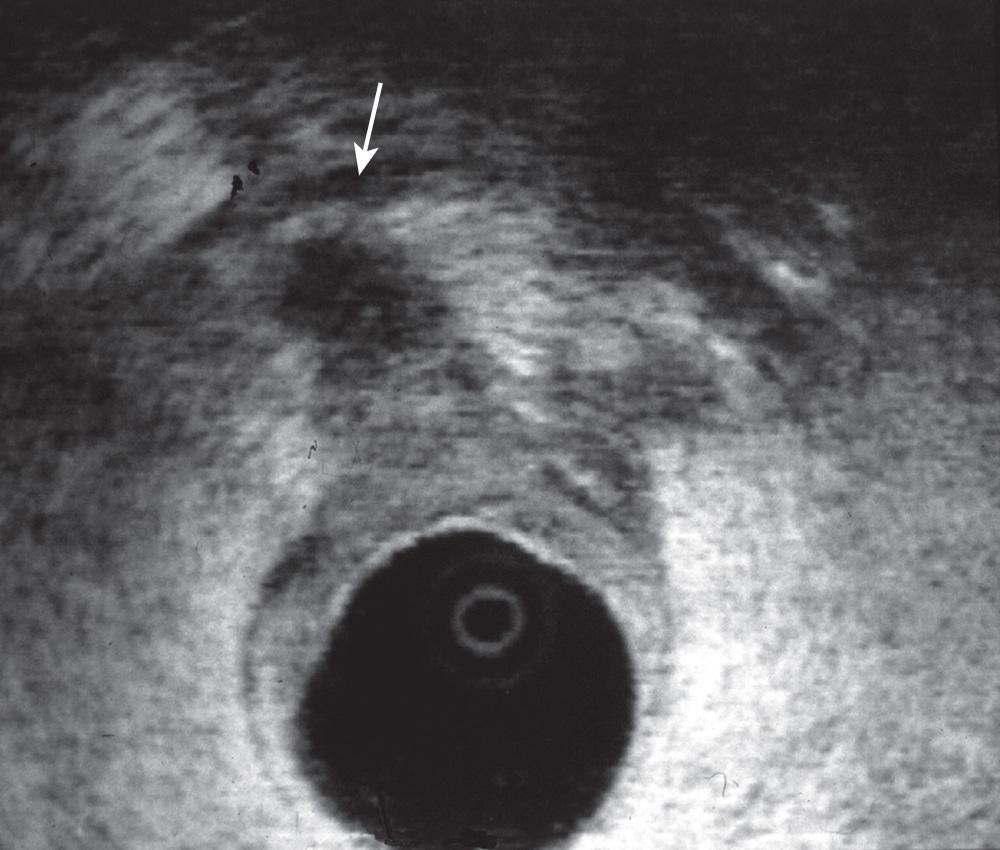
Become a Clinical Tree membership for Full access and enjoy Unlimited articles
If you are a member. Log in here